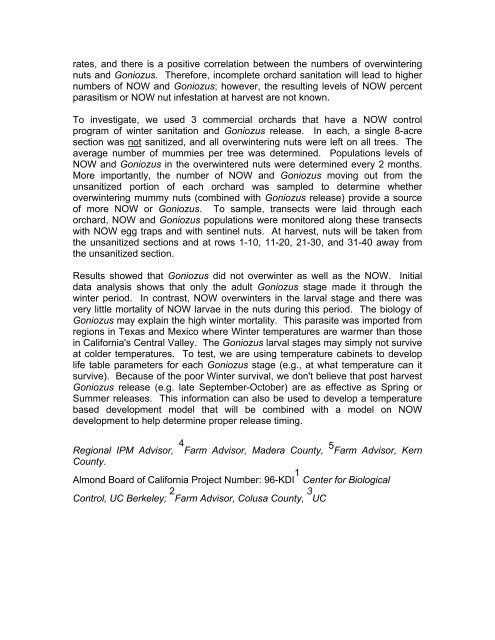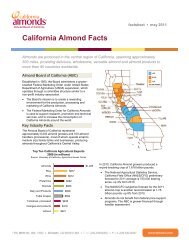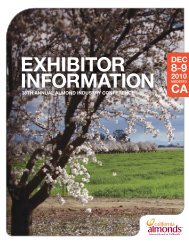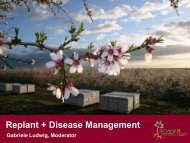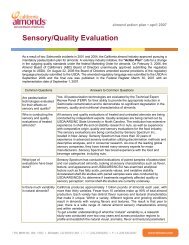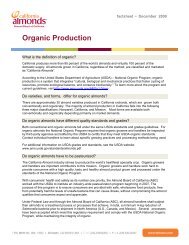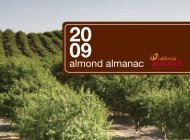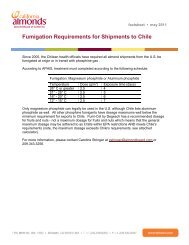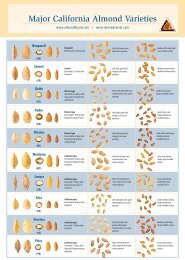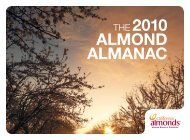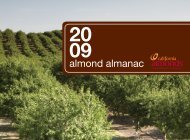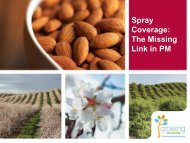Release of Goniozus legneri for Navel Orangeworm (NOW)
Release of Goniozus legneri for Navel Orangeworm (NOW)
Release of Goniozus legneri for Navel Orangeworm (NOW)
You also want an ePaper? Increase the reach of your titles
YUMPU automatically turns print PDFs into web optimized ePapers that Google loves.
ates, and there is a positive correlation between the numbers <strong>of</strong> overwinteringnuts and <strong>Goniozus</strong>. There<strong>for</strong>e, incomplete orchard sanitation will lead to highernumbers <strong>of</strong> <strong>NOW</strong> and <strong>Goniozus</strong>; however, the resulting levels <strong>of</strong> <strong>NOW</strong> percentparasitism or <strong>NOW</strong> nut infestation at harvest are not known.To investigate, we used 3 commercial orchards that have a <strong>NOW</strong> controlprogram <strong>of</strong> winter sanitation and <strong>Goniozus</strong> release. In each, a single 8-acresection was not sanitized, and all overwintering nuts were left on all trees. Theaverage number <strong>of</strong> mummies per tree was determined. Populations levels <strong>of</strong><strong>NOW</strong> and <strong>Goniozus</strong> in the overwintered nuts were determined every 2 months.More importantly, the number <strong>of</strong> <strong>NOW</strong> and <strong>Goniozus</strong> moving out from theunsanitized portion <strong>of</strong> each orchard was sampled to determine whetheroverwintering mummy nuts (combined with <strong>Goniozus</strong> release) provide a source<strong>of</strong> more <strong>NOW</strong> or <strong>Goniozus</strong>. To sample, transects were laid through eachorchard, <strong>NOW</strong> and <strong>Goniozus</strong> populations were monitored along these transectswith <strong>NOW</strong> egg traps and with sentinel nuts. At harvest, nuts will be taken fromthe unsanitized sections and at rows 1-10, 11-20, 21-30, and 31-40 away fromthe unsanitized section.Results showed that <strong>Goniozus</strong> did not overwinter as well as the <strong>NOW</strong>. Initialdata analysis shows that only the adult <strong>Goniozus</strong> stage made it through thewinter period. In contrast, <strong>NOW</strong> overwinters in the larval stage and there wasvery little mortality <strong>of</strong> <strong>NOW</strong> larvae in the nuts during this period. The biology <strong>of</strong><strong>Goniozus</strong> may explain the high winter mortality. This parasite was imported fromregions in Texas and Mexico where Winter temperatures are warmer than thosein Cali<strong>for</strong>nia's Central Valley. The <strong>Goniozus</strong> larval stages may simply not surviveat colder temperatures. To test, we are using temperature cabinets to developlife table parameters <strong>for</strong> each <strong>Goniozus</strong> stage (e.g., at what temperature can itsurvive). Because <strong>of</strong> the poor Winter survival, we don't believe that post harvest<strong>Goniozus</strong> release (e.g. late September-October) are as effective as Spring orSummer releases. This in<strong>for</strong>mation can also be used to develop a temperaturebased development model that will be combined with a model on <strong>NOW</strong>development to help determine proper release timing.Regional IPM Advisor, 4 Farm Advisor, Madera County, 5 Farm Advisor, KernCounty.Almond Board <strong>of</strong> Cali<strong>for</strong>nia Project Number: 96-KDI 1 Center <strong>for</strong> BiologicalControl, UC Berkeley; 2 Farm Advisor, Colusa County, 3 UC


